Contemporary Business Economics
VerifiedAdded on 2023/01/05
|12
|3244
|70
AI Summary
This document provides an overview of business economics and its relevance to modern business practices. It covers topics such as the law of demand, law of supply, and the movement along the demand and supply curves. It also compares and contrasts emerging theories and models in the 21st century with those from the 20th century.
Contribute Materials
Your contribution can guide someone’s learning journey. Share your
documents today.
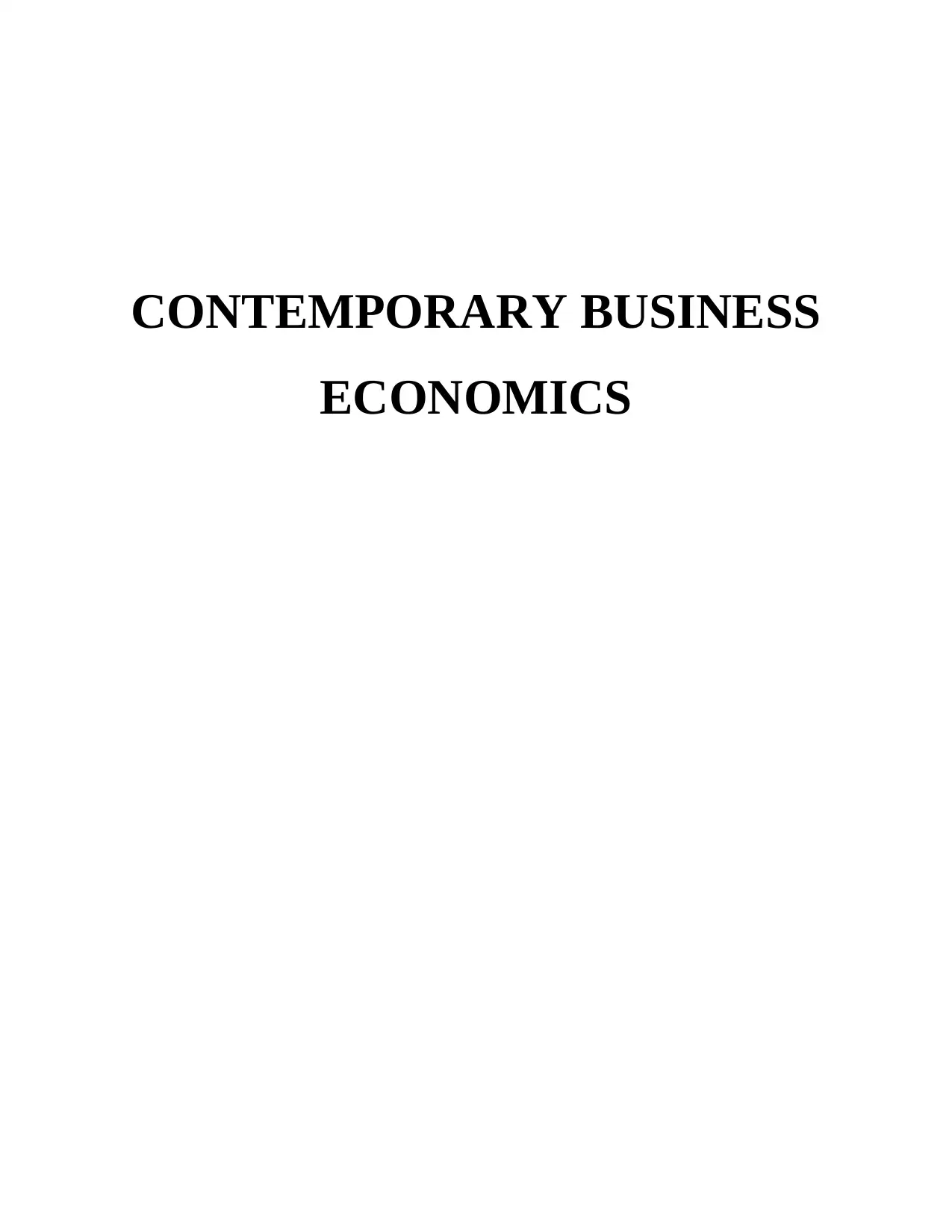
CONTEMPORARY BUSINESS
ECONOMICS
ECONOMICS
Secure Best Marks with AI Grader
Need help grading? Try our AI Grader for instant feedback on your assignments.
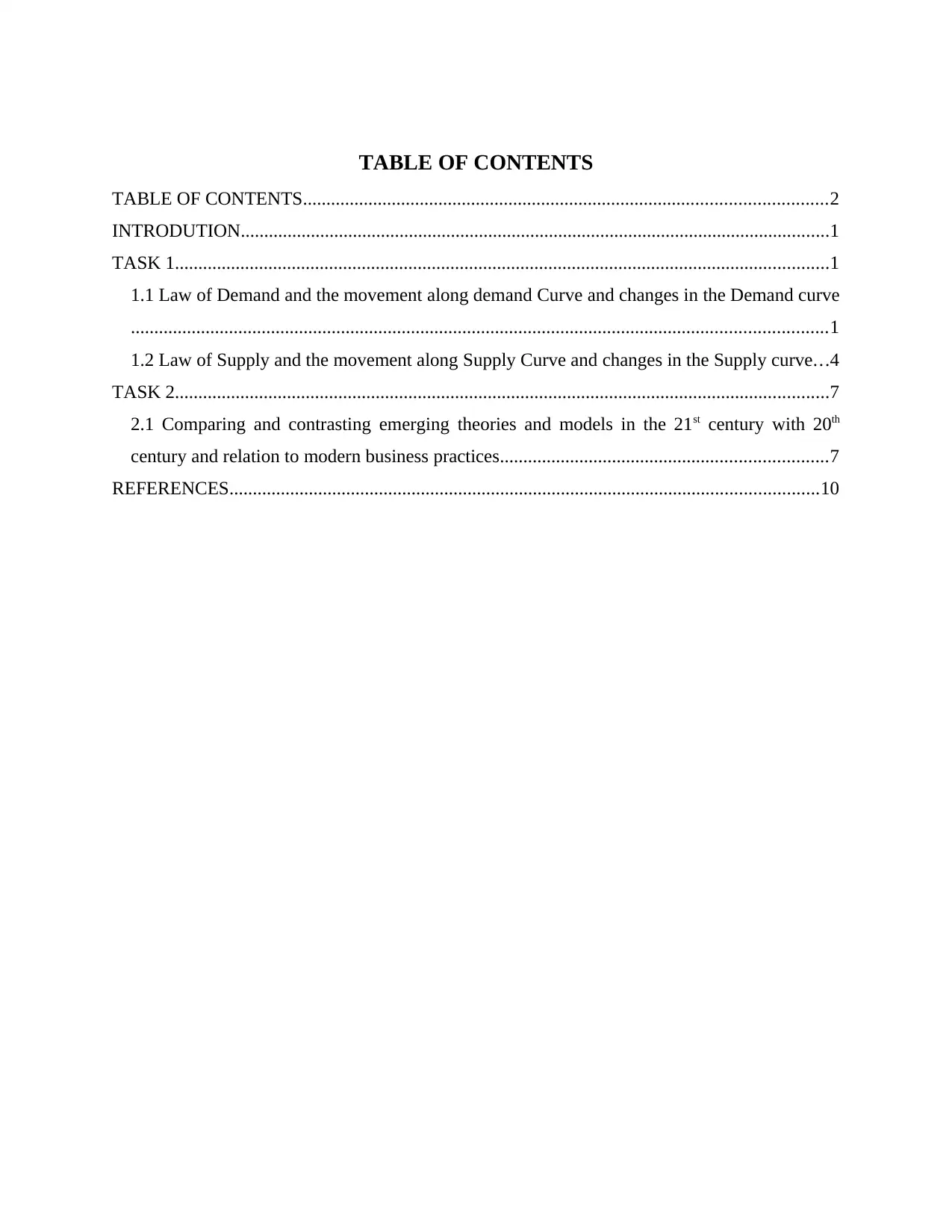
TABLE OF CONTENTS
TABLE OF CONTENTS................................................................................................................2
INTRODUTION..............................................................................................................................1
TASK 1............................................................................................................................................1
1.1 Law of Demand and the movement along demand Curve and changes in the Demand curve
.....................................................................................................................................................1
1.2 Law of Supply and the movement along Supply Curve and changes in the Supply curve...4
TASK 2............................................................................................................................................7
2.1 Comparing and contrasting emerging theories and models in the 21st century with 20th
century and relation to modern business practices......................................................................7
REFERENCES..............................................................................................................................10
TABLE OF CONTENTS................................................................................................................2
INTRODUTION..............................................................................................................................1
TASK 1............................................................................................................................................1
1.1 Law of Demand and the movement along demand Curve and changes in the Demand curve
.....................................................................................................................................................1
1.2 Law of Supply and the movement along Supply Curve and changes in the Supply curve...4
TASK 2............................................................................................................................................7
2.1 Comparing and contrasting emerging theories and models in the 21st century with 20th
century and relation to modern business practices......................................................................7
REFERENCES..............................................................................................................................10
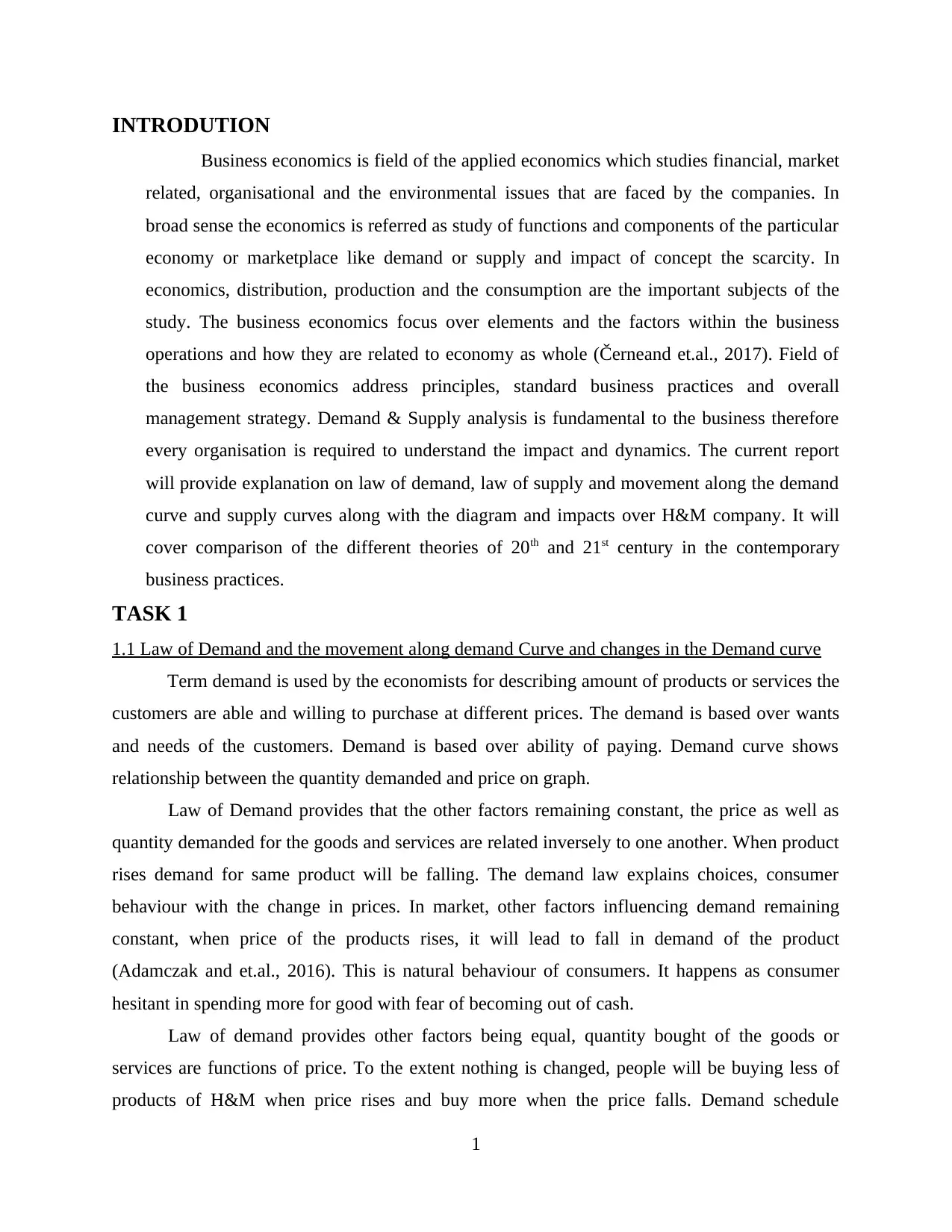
INTRODUTION
Business economics is field of the applied economics which studies financial, market
related, organisational and the environmental issues that are faced by the companies. In
broad sense the economics is referred as study of functions and components of the particular
economy or marketplace like demand or supply and impact of concept the scarcity. In
economics, distribution, production and the consumption are the important subjects of the
study. The business economics focus over elements and the factors within the business
operations and how they are related to economy as whole (Černeand et.al., 2017). Field of
the business economics address principles, standard business practices and overall
management strategy. Demand & Supply analysis is fundamental to the business therefore
every organisation is required to understand the impact and dynamics. The current report
will provide explanation on law of demand, law of supply and movement along the demand
curve and supply curves along with the diagram and impacts over H&M company. It will
cover comparison of the different theories of 20th and 21st century in the contemporary
business practices.
TASK 1
1.1 Law of Demand and the movement along demand Curve and changes in the Demand curve
Term demand is used by the economists for describing amount of products or services the
customers are able and willing to purchase at different prices. The demand is based over wants
and needs of the customers. Demand is based over ability of paying. Demand curve shows
relationship between the quantity demanded and price on graph.
Law of Demand provides that the other factors remaining constant, the price as well as
quantity demanded for the goods and services are related inversely to one another. When product
rises demand for same product will be falling. The demand law explains choices, consumer
behaviour with the change in prices. In market, other factors influencing demand remaining
constant, when price of the products rises, it will lead to fall in demand of the product
(Adamczak and et.al., 2016). This is natural behaviour of consumers. It happens as consumer
hesitant in spending more for good with fear of becoming out of cash.
Law of demand provides other factors being equal, quantity bought of the goods or
services are functions of price. To the extent nothing is changed, people will be buying less of
products of H&M when price rises and buy more when the price falls. Demand schedule
1
Business economics is field of the applied economics which studies financial, market
related, organisational and the environmental issues that are faced by the companies. In
broad sense the economics is referred as study of functions and components of the particular
economy or marketplace like demand or supply and impact of concept the scarcity. In
economics, distribution, production and the consumption are the important subjects of the
study. The business economics focus over elements and the factors within the business
operations and how they are related to economy as whole (Černeand et.al., 2017). Field of
the business economics address principles, standard business practices and overall
management strategy. Demand & Supply analysis is fundamental to the business therefore
every organisation is required to understand the impact and dynamics. The current report
will provide explanation on law of demand, law of supply and movement along the demand
curve and supply curves along with the diagram and impacts over H&M company. It will
cover comparison of the different theories of 20th and 21st century in the contemporary
business practices.
TASK 1
1.1 Law of Demand and the movement along demand Curve and changes in the Demand curve
Term demand is used by the economists for describing amount of products or services the
customers are able and willing to purchase at different prices. The demand is based over wants
and needs of the customers. Demand is based over ability of paying. Demand curve shows
relationship between the quantity demanded and price on graph.
Law of Demand provides that the other factors remaining constant, the price as well as
quantity demanded for the goods and services are related inversely to one another. When product
rises demand for same product will be falling. The demand law explains choices, consumer
behaviour with the change in prices. In market, other factors influencing demand remaining
constant, when price of the products rises, it will lead to fall in demand of the product
(Adamczak and et.al., 2016). This is natural behaviour of consumers. It happens as consumer
hesitant in spending more for good with fear of becoming out of cash.
Law of demand provides other factors being equal, quantity bought of the goods or
services are functions of price. To the extent nothing is changed, people will be buying less of
products of H&M when price rises and buy more when the price falls. Demand schedule
1
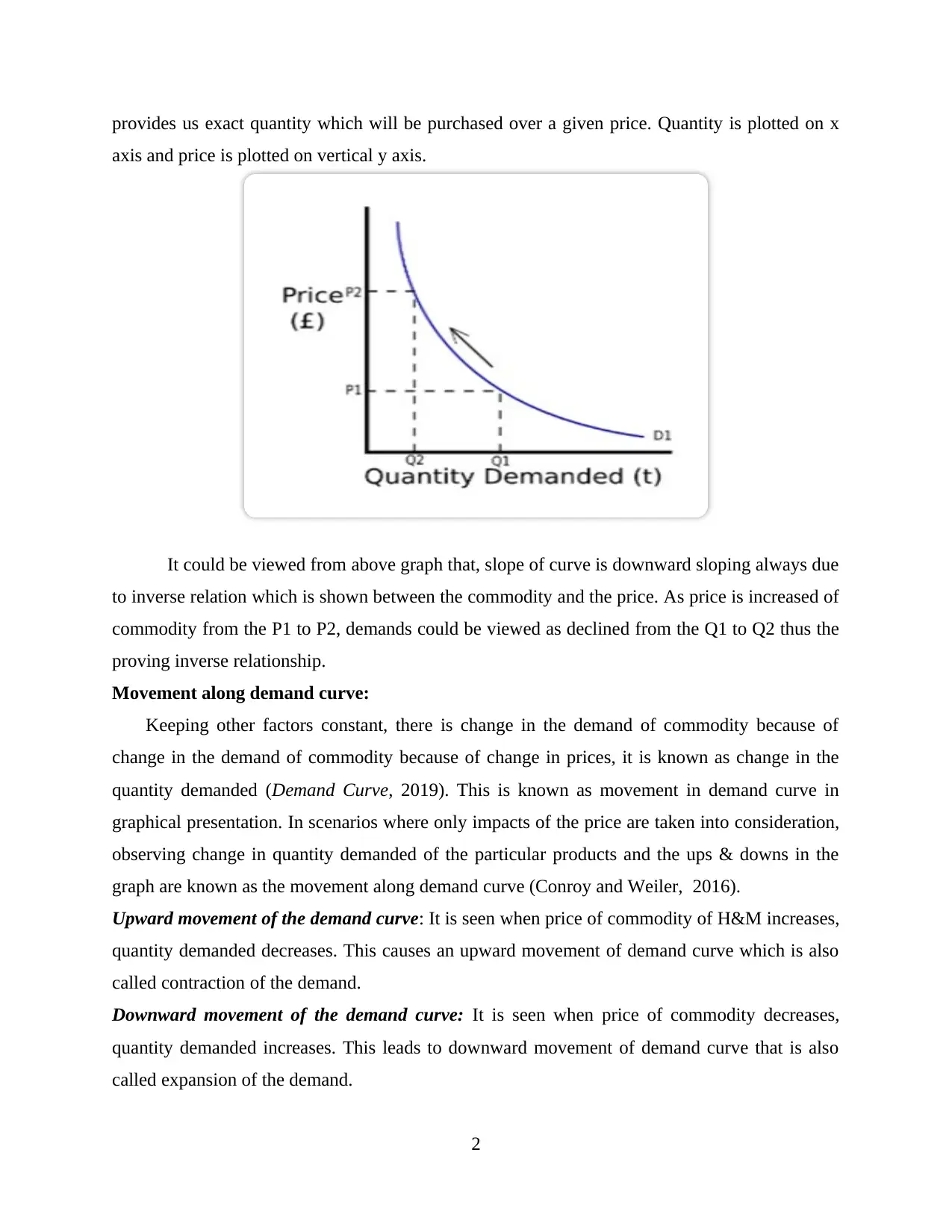
provides us exact quantity which will be purchased over a given price. Quantity is plotted on x
axis and price is plotted on vertical y axis.
It could be viewed from above graph that, slope of curve is downward sloping always due
to inverse relation which is shown between the commodity and the price. As price is increased of
commodity from the P1 to P2, demands could be viewed as declined from the Q1 to Q2 thus the
proving inverse relationship.
Movement along demand curve:
Keeping other factors constant, there is change in the demand of commodity because of
change in the demand of commodity because of change in prices, it is known as change in the
quantity demanded (Demand Curve, 2019). This is known as movement in demand curve in
graphical presentation. In scenarios where only impacts of the price are taken into consideration,
observing change in quantity demanded of the particular products and the ups & downs in the
graph are known as the movement along demand curve (Conroy and Weiler, 2016).
Upward movement of the demand curve: It is seen when price of commodity of H&M increases,
quantity demanded decreases. This causes an upward movement of demand curve which is also
called contraction of the demand.
Downward movement of the demand curve: It is seen when price of commodity decreases,
quantity demanded increases. This leads to downward movement of demand curve that is also
called expansion of the demand.
2
axis and price is plotted on vertical y axis.
It could be viewed from above graph that, slope of curve is downward sloping always due
to inverse relation which is shown between the commodity and the price. As price is increased of
commodity from the P1 to P2, demands could be viewed as declined from the Q1 to Q2 thus the
proving inverse relationship.
Movement along demand curve:
Keeping other factors constant, there is change in the demand of commodity because of
change in the demand of commodity because of change in prices, it is known as change in the
quantity demanded (Demand Curve, 2019). This is known as movement in demand curve in
graphical presentation. In scenarios where only impacts of the price are taken into consideration,
observing change in quantity demanded of the particular products and the ups & downs in the
graph are known as the movement along demand curve (Conroy and Weiler, 2016).
Upward movement of the demand curve: It is seen when price of commodity of H&M increases,
quantity demanded decreases. This causes an upward movement of demand curve which is also
called contraction of the demand.
Downward movement of the demand curve: It is seen when price of commodity decreases,
quantity demanded increases. This leads to downward movement of demand curve that is also
called expansion of the demand.
2
Secure Best Marks with AI Grader
Need help grading? Try our AI Grader for instant feedback on your assignments.
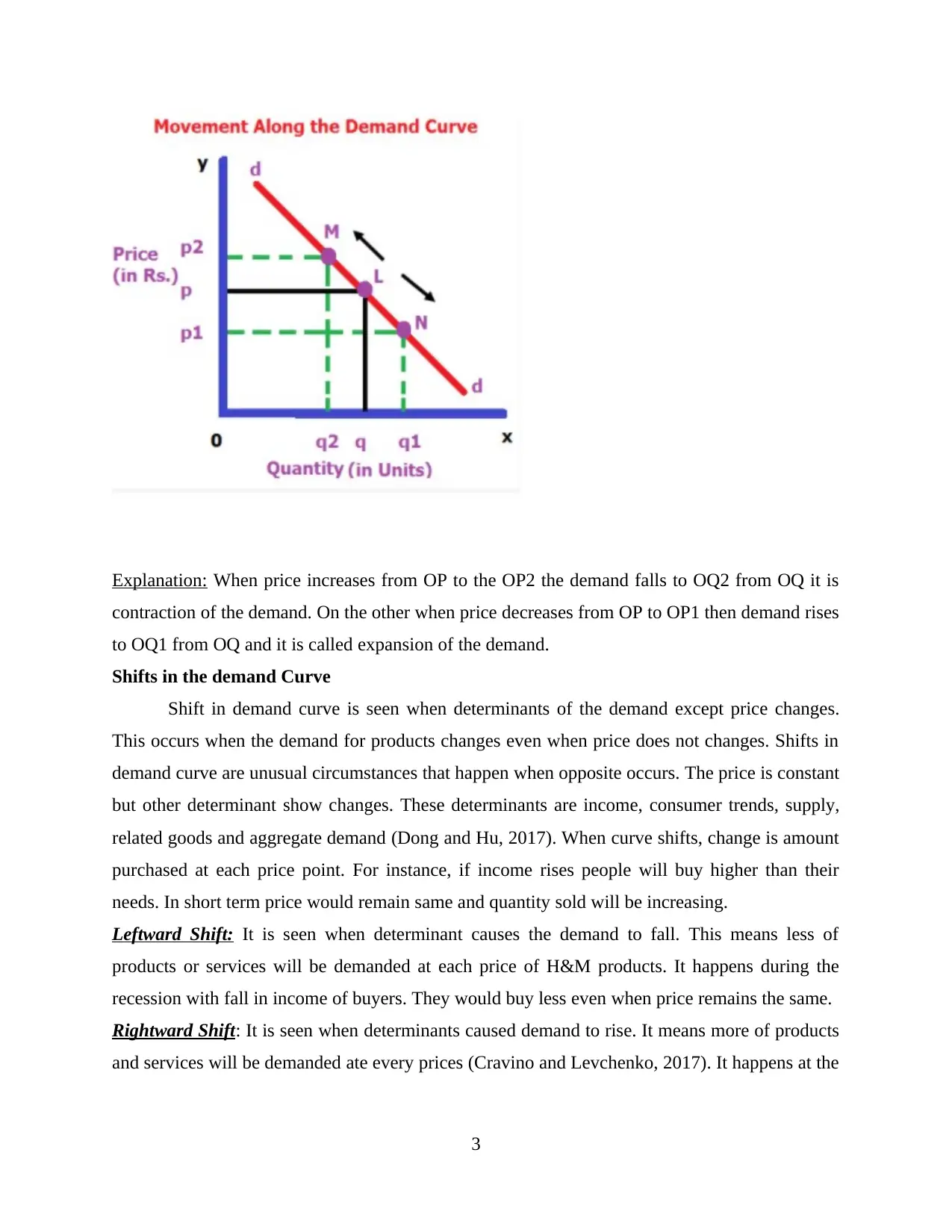
Explanation: When price increases from OP to the OP2 the demand falls to OQ2 from OQ it is
contraction of the demand. On the other when price decreases from OP to OP1 then demand rises
to OQ1 from OQ and it is called expansion of the demand.
Shifts in the demand Curve
Shift in demand curve is seen when determinants of the demand except price changes.
This occurs when the demand for products changes even when price does not changes. Shifts in
demand curve are unusual circumstances that happen when opposite occurs. The price is constant
but other determinant show changes. These determinants are income, consumer trends, supply,
related goods and aggregate demand (Dong and Hu, 2017). When curve shifts, change is amount
purchased at each price point. For instance, if income rises people will buy higher than their
needs. In short term price would remain same and quantity sold will be increasing.
Leftward Shift: It is seen when determinant causes the demand to fall. This means less of
products or services will be demanded at each price of H&M products. It happens during the
recession with fall in income of buyers. They would buy less even when price remains the same.
Rightward Shift: It is seen when determinants caused demand to rise. It means more of products
and services will be demanded ate every prices (Cravino and Levchenko, 2017). It happens at the
3
contraction of the demand. On the other when price decreases from OP to OP1 then demand rises
to OQ1 from OQ and it is called expansion of the demand.
Shifts in the demand Curve
Shift in demand curve is seen when determinants of the demand except price changes.
This occurs when the demand for products changes even when price does not changes. Shifts in
demand curve are unusual circumstances that happen when opposite occurs. The price is constant
but other determinant show changes. These determinants are income, consumer trends, supply,
related goods and aggregate demand (Dong and Hu, 2017). When curve shifts, change is amount
purchased at each price point. For instance, if income rises people will buy higher than their
needs. In short term price would remain same and quantity sold will be increasing.
Leftward Shift: It is seen when determinant causes the demand to fall. This means less of
products or services will be demanded at each price of H&M products. It happens during the
recession with fall in income of buyers. They would buy less even when price remains the same.
Rightward Shift: It is seen when determinants caused demand to rise. It means more of products
and services will be demanded ate every prices (Cravino and Levchenko, 2017). It happens at the
3
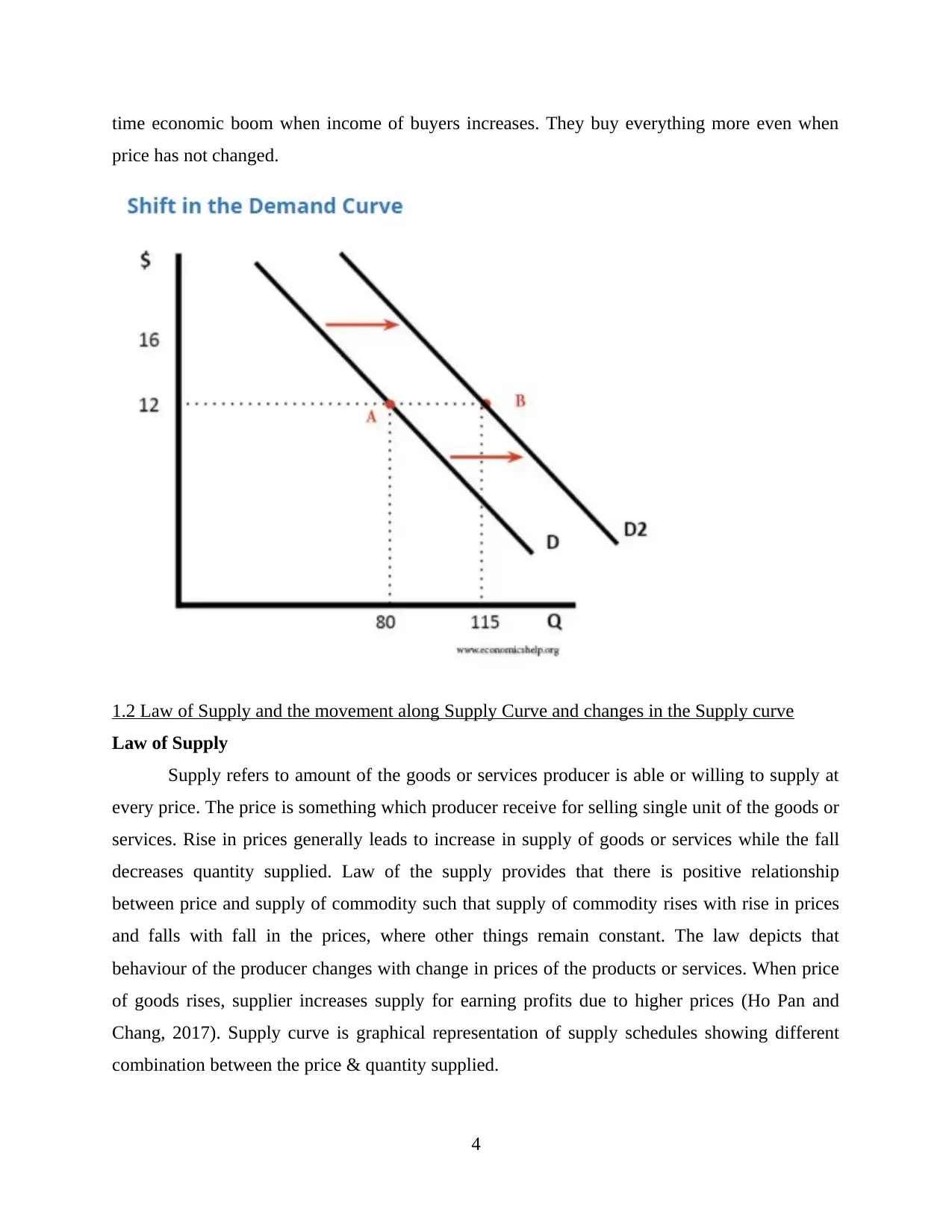
time economic boom when income of buyers increases. They buy everything more even when
price has not changed.
1.2 Law of Supply and the movement along Supply Curve and changes in the Supply curve
Law of Supply
Supply refers to amount of the goods or services producer is able or willing to supply at
every price. The price is something which producer receive for selling single unit of the goods or
services. Rise in prices generally leads to increase in supply of goods or services while the fall
decreases quantity supplied. Law of the supply provides that there is positive relationship
between price and supply of commodity such that supply of commodity rises with rise in prices
and falls with fall in the prices, where other things remain constant. The law depicts that
behaviour of the producer changes with change in prices of the products or services. When price
of goods rises, supplier increases supply for earning profits due to higher prices (Ho Pan and
Chang, 2017). Supply curve is graphical representation of supply schedules showing different
combination between the price & quantity supplied.
4
price has not changed.
1.2 Law of Supply and the movement along Supply Curve and changes in the Supply curve
Law of Supply
Supply refers to amount of the goods or services producer is able or willing to supply at
every price. The price is something which producer receive for selling single unit of the goods or
services. Rise in prices generally leads to increase in supply of goods or services while the fall
decreases quantity supplied. Law of the supply provides that there is positive relationship
between price and supply of commodity such that supply of commodity rises with rise in prices
and falls with fall in the prices, where other things remain constant. The law depicts that
behaviour of the producer changes with change in prices of the products or services. When price
of goods rises, supplier increases supply for earning profits due to higher prices (Ho Pan and
Chang, 2017). Supply curve is graphical representation of supply schedules showing different
combination between the price & quantity supplied.
4
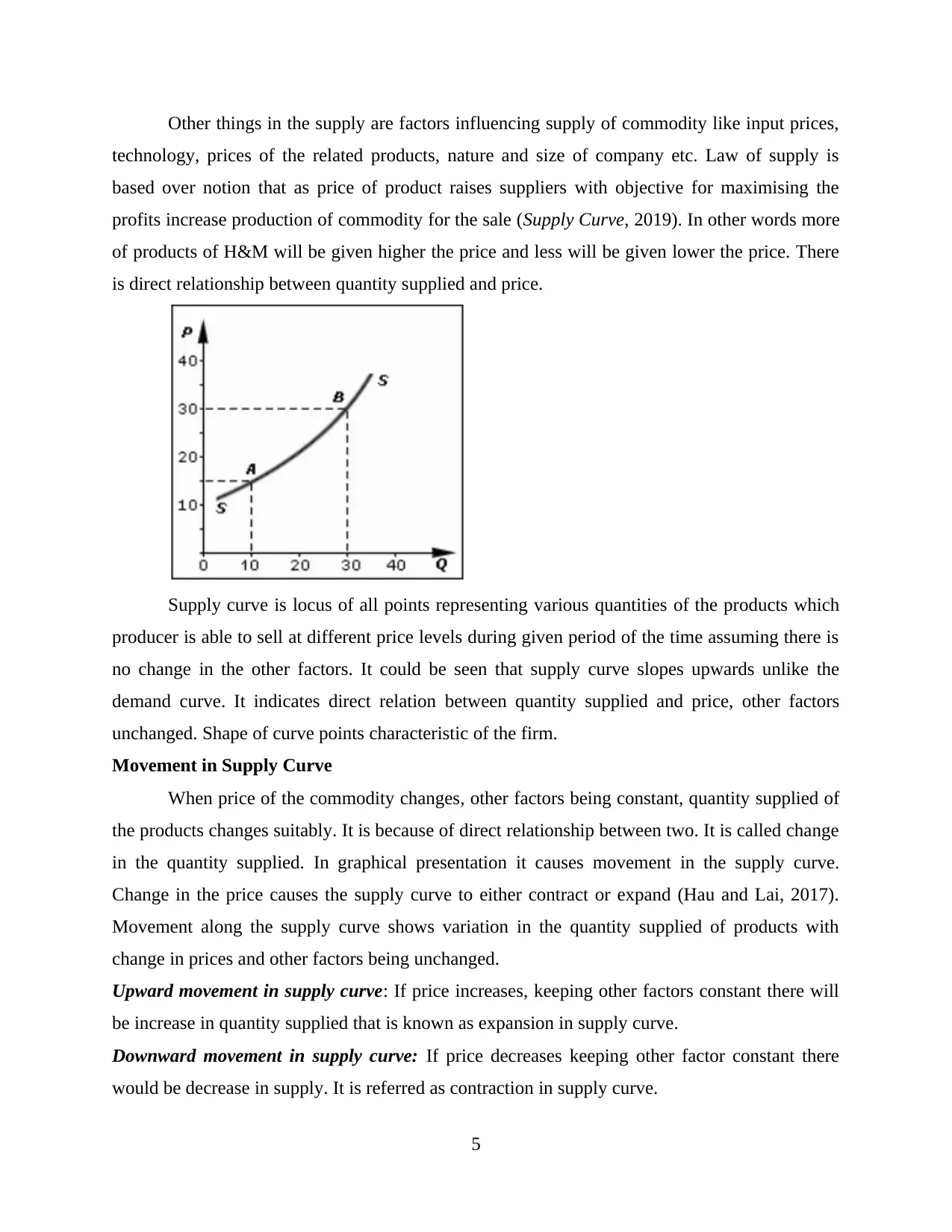
Other things in the supply are factors influencing supply of commodity like input prices,
technology, prices of the related products, nature and size of company etc. Law of supply is
based over notion that as price of product raises suppliers with objective for maximising the
profits increase production of commodity for the sale (Supply Curve, 2019). In other words more
of products of H&M will be given higher the price and less will be given lower the price. There
is direct relationship between quantity supplied and price.
Supply curve is locus of all points representing various quantities of the products which
producer is able to sell at different price levels during given period of the time assuming there is
no change in the other factors. It could be seen that supply curve slopes upwards unlike the
demand curve. It indicates direct relation between quantity supplied and price, other factors
unchanged. Shape of curve points characteristic of the firm.
Movement in Supply Curve
When price of the commodity changes, other factors being constant, quantity supplied of
the products changes suitably. It is because of direct relationship between two. It is called change
in the quantity supplied. In graphical presentation it causes movement in the supply curve.
Change in the price causes the supply curve to either contract or expand (Hau and Lai, 2017).
Movement along the supply curve shows variation in the quantity supplied of products with
change in prices and other factors being unchanged.
Upward movement in supply curve: If price increases, keeping other factors constant there will
be increase in quantity supplied that is known as expansion in supply curve.
Downward movement in supply curve: If price decreases keeping other factor constant there
would be decrease in supply. It is referred as contraction in supply curve.
5
technology, prices of the related products, nature and size of company etc. Law of supply is
based over notion that as price of product raises suppliers with objective for maximising the
profits increase production of commodity for the sale (Supply Curve, 2019). In other words more
of products of H&M will be given higher the price and less will be given lower the price. There
is direct relationship between quantity supplied and price.
Supply curve is locus of all points representing various quantities of the products which
producer is able to sell at different price levels during given period of the time assuming there is
no change in the other factors. It could be seen that supply curve slopes upwards unlike the
demand curve. It indicates direct relation between quantity supplied and price, other factors
unchanged. Shape of curve points characteristic of the firm.
Movement in Supply Curve
When price of the commodity changes, other factors being constant, quantity supplied of
the products changes suitably. It is because of direct relationship between two. It is called change
in the quantity supplied. In graphical presentation it causes movement in the supply curve.
Change in the price causes the supply curve to either contract or expand (Hau and Lai, 2017).
Movement along the supply curve shows variation in the quantity supplied of products with
change in prices and other factors being unchanged.
Upward movement in supply curve: If price increases, keeping other factors constant there will
be increase in quantity supplied that is known as expansion in supply curve.
Downward movement in supply curve: If price decreases keeping other factor constant there
would be decrease in supply. It is referred as contraction in supply curve.
5
Paraphrase This Document
Need a fresh take? Get an instant paraphrase of this document with our AI Paraphraser
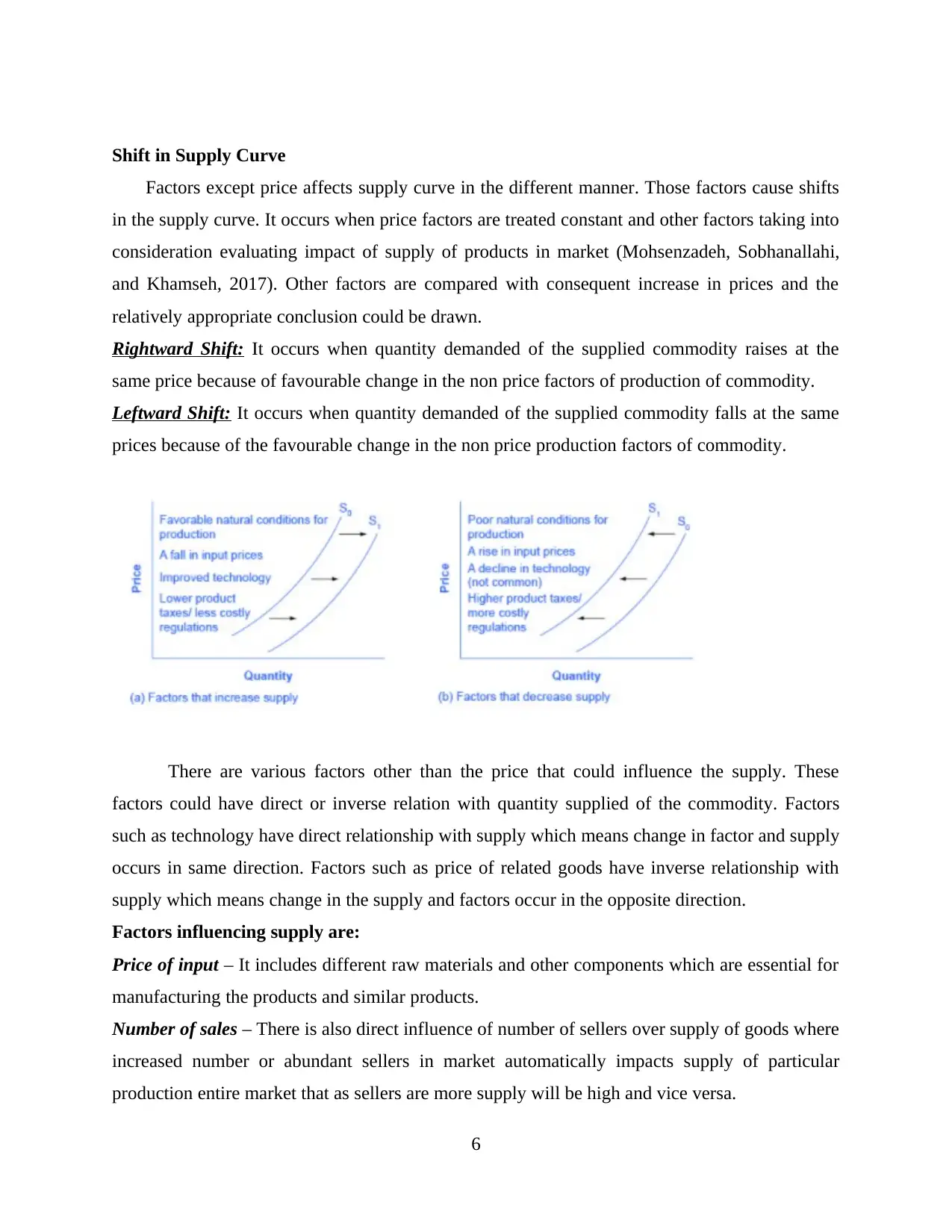
Shift in Supply Curve
Factors except price affects supply curve in the different manner. Those factors cause shifts
in the supply curve. It occurs when price factors are treated constant and other factors taking into
consideration evaluating impact of supply of products in market (Mohsenzadeh, Sobhanallahi,
and Khamseh, 2017). Other factors are compared with consequent increase in prices and the
relatively appropriate conclusion could be drawn.
Rightward Shift: It occurs when quantity demanded of the supplied commodity raises at the
same price because of favourable change in the non price factors of production of commodity.
Leftward Shift: It occurs when quantity demanded of the supplied commodity falls at the same
prices because of the favourable change in the non price production factors of commodity.
There are various factors other than the price that could influence the supply. These
factors could have direct or inverse relation with quantity supplied of the commodity. Factors
such as technology have direct relationship with supply which means change in factor and supply
occurs in same direction. Factors such as price of related goods have inverse relationship with
supply which means change in the supply and factors occur in the opposite direction.
Factors influencing supply are:
Price of input – It includes different raw materials and other components which are essential for
manufacturing the products and similar products.
Number of sales – There is also direct influence of number of sellers over supply of goods where
increased number or abundant sellers in market automatically impacts supply of particular
production entire market that as sellers are more supply will be high and vice versa.
6
Factors except price affects supply curve in the different manner. Those factors cause shifts
in the supply curve. It occurs when price factors are treated constant and other factors taking into
consideration evaluating impact of supply of products in market (Mohsenzadeh, Sobhanallahi,
and Khamseh, 2017). Other factors are compared with consequent increase in prices and the
relatively appropriate conclusion could be drawn.
Rightward Shift: It occurs when quantity demanded of the supplied commodity raises at the
same price because of favourable change in the non price factors of production of commodity.
Leftward Shift: It occurs when quantity demanded of the supplied commodity falls at the same
prices because of the favourable change in the non price production factors of commodity.
There are various factors other than the price that could influence the supply. These
factors could have direct or inverse relation with quantity supplied of the commodity. Factors
such as technology have direct relationship with supply which means change in factor and supply
occurs in same direction. Factors such as price of related goods have inverse relationship with
supply which means change in the supply and factors occur in the opposite direction.
Factors influencing supply are:
Price of input – It includes different raw materials and other components which are essential for
manufacturing the products and similar products.
Number of sales – There is also direct influence of number of sellers over supply of goods where
increased number or abundant sellers in market automatically impacts supply of particular
production entire market that as sellers are more supply will be high and vice versa.
6
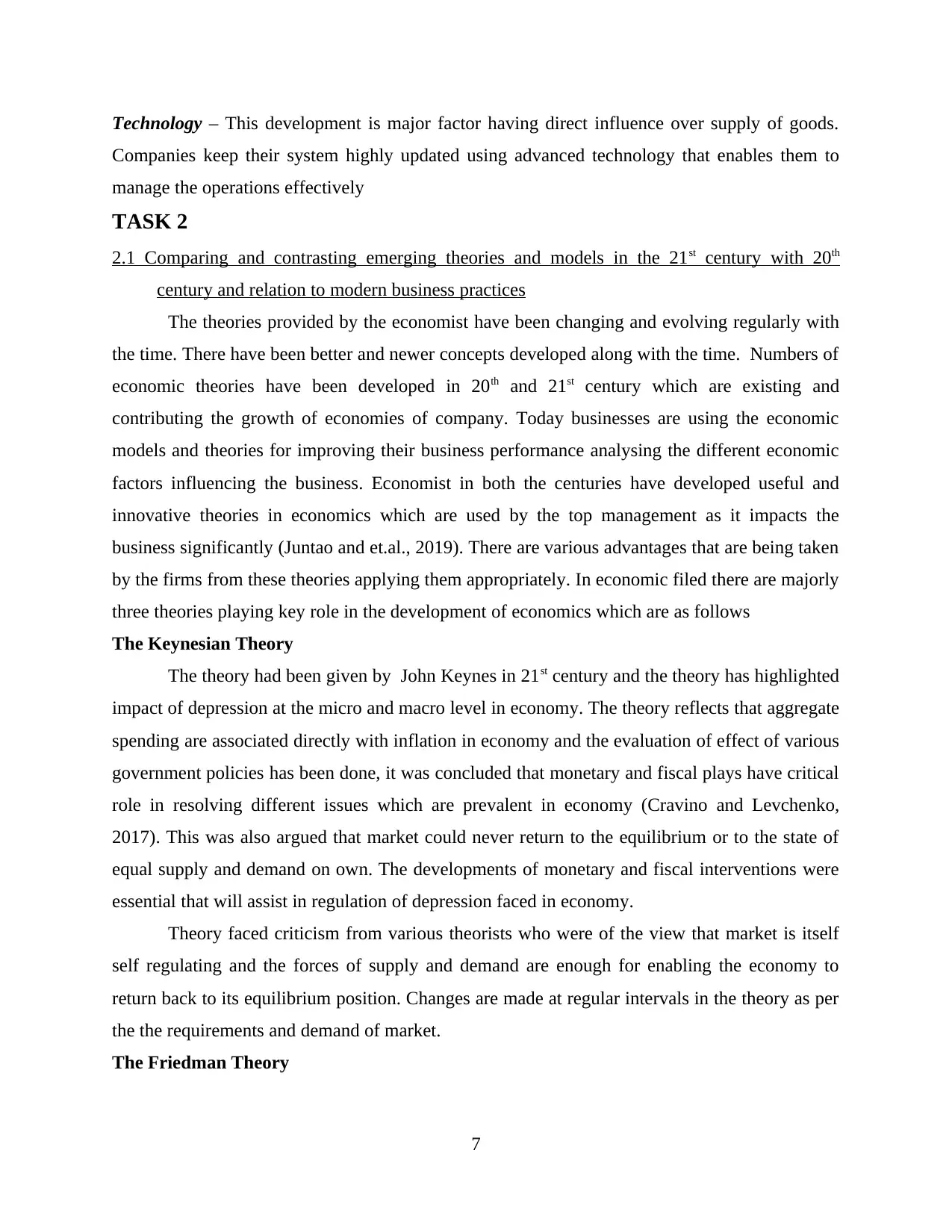
Technology – This development is major factor having direct influence over supply of goods.
Companies keep their system highly updated using advanced technology that enables them to
manage the operations effectively
TASK 2
2.1 Comparing and contrasting emerging theories and models in the 21st century with 20th
century and relation to modern business practices
The theories provided by the economist have been changing and evolving regularly with
the time. There have been better and newer concepts developed along with the time. Numbers of
economic theories have been developed in 20th and 21st century which are existing and
contributing the growth of economies of company. Today businesses are using the economic
models and theories for improving their business performance analysing the different economic
factors influencing the business. Economist in both the centuries have developed useful and
innovative theories in economics which are used by the top management as it impacts the
business significantly (Juntao and et.al., 2019). There are various advantages that are being taken
by the firms from these theories applying them appropriately. In economic filed there are majorly
three theories playing key role in the development of economics which are as follows
The Keynesian Theory
The theory had been given by John Keynes in 21st century and the theory has highlighted
impact of depression at the micro and macro level in economy. The theory reflects that aggregate
spending are associated directly with inflation in economy and the evaluation of effect of various
government policies has been done, it was concluded that monetary and fiscal plays have critical
role in resolving different issues which are prevalent in economy (Cravino and Levchenko,
2017). This was also argued that market could never return to the equilibrium or to the state of
equal supply and demand on own. The developments of monetary and fiscal interventions were
essential that will assist in regulation of depression faced in economy.
Theory faced criticism from various theorists who were of the view that market is itself
self regulating and the forces of supply and demand are enough for enabling the economy to
return back to its equilibrium position. Changes are made at regular intervals in the theory as per
the the requirements and demand of market.
The Friedman Theory
7
Companies keep their system highly updated using advanced technology that enables them to
manage the operations effectively
TASK 2
2.1 Comparing and contrasting emerging theories and models in the 21st century with 20th
century and relation to modern business practices
The theories provided by the economist have been changing and evolving regularly with
the time. There have been better and newer concepts developed along with the time. Numbers of
economic theories have been developed in 20th and 21st century which are existing and
contributing the growth of economies of company. Today businesses are using the economic
models and theories for improving their business performance analysing the different economic
factors influencing the business. Economist in both the centuries have developed useful and
innovative theories in economics which are used by the top management as it impacts the
business significantly (Juntao and et.al., 2019). There are various advantages that are being taken
by the firms from these theories applying them appropriately. In economic filed there are majorly
three theories playing key role in the development of economics which are as follows
The Keynesian Theory
The theory had been given by John Keynes in 21st century and the theory has highlighted
impact of depression at the micro and macro level in economy. The theory reflects that aggregate
spending are associated directly with inflation in economy and the evaluation of effect of various
government policies has been done, it was concluded that monetary and fiscal plays have critical
role in resolving different issues which are prevalent in economy (Cravino and Levchenko,
2017). This was also argued that market could never return to the equilibrium or to the state of
equal supply and demand on own. The developments of monetary and fiscal interventions were
essential that will assist in regulation of depression faced in economy.
Theory faced criticism from various theorists who were of the view that market is itself
self regulating and the forces of supply and demand are enough for enabling the economy to
return back to its equilibrium position. Changes are made at regular intervals in the theory as per
the the requirements and demand of market.
The Friedman Theory
7
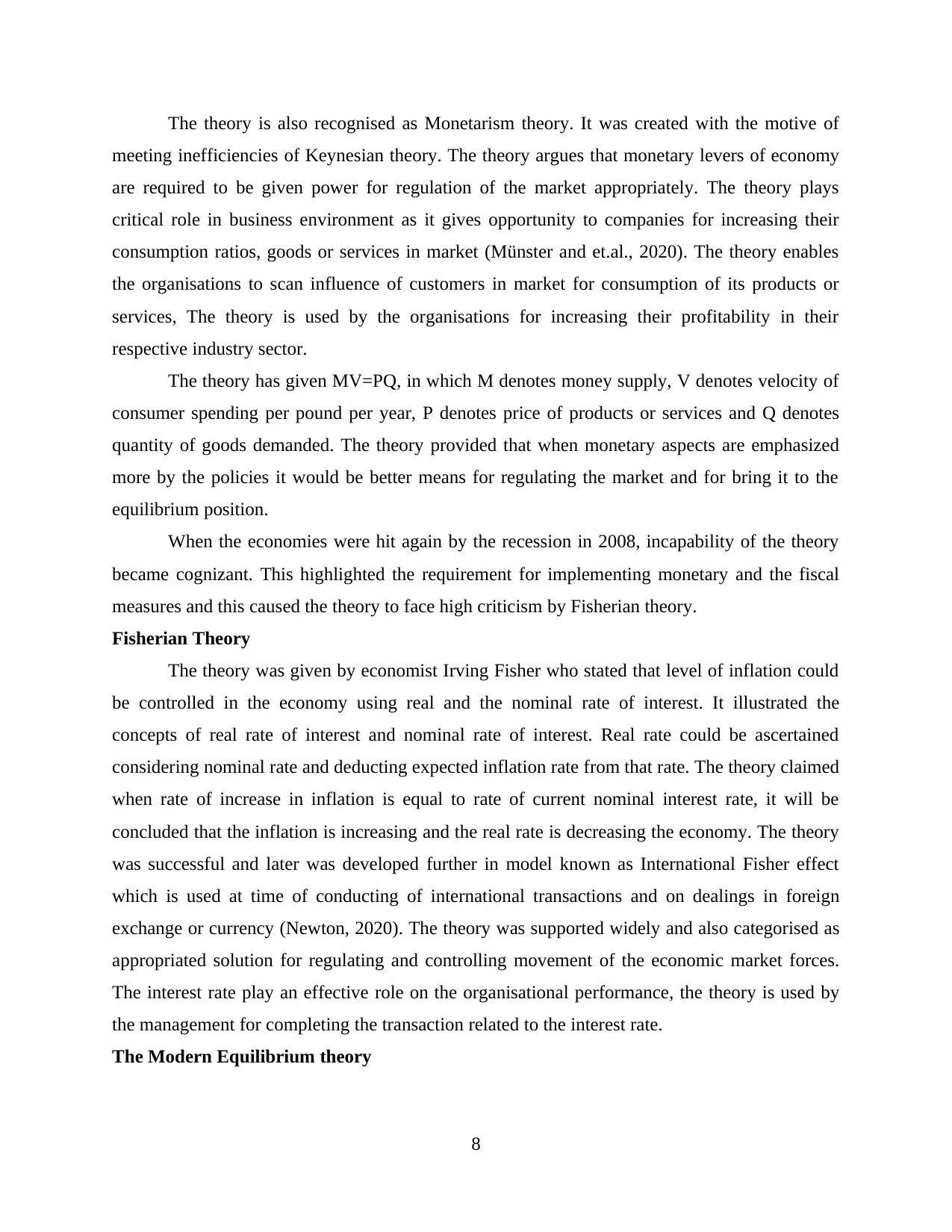
The theory is also recognised as Monetarism theory. It was created with the motive of
meeting inefficiencies of Keynesian theory. The theory argues that monetary levers of economy
are required to be given power for regulation of the market appropriately. The theory plays
critical role in business environment as it gives opportunity to companies for increasing their
consumption ratios, goods or services in market (Münster and et.al., 2020). The theory enables
the organisations to scan influence of customers in market for consumption of its products or
services, The theory is used by the organisations for increasing their profitability in their
respective industry sector.
The theory has given MV=PQ, in which M denotes money supply, V denotes velocity of
consumer spending per pound per year, P denotes price of products or services and Q denotes
quantity of goods demanded. The theory provided that when monetary aspects are emphasized
more by the policies it would be better means for regulating the market and for bring it to the
equilibrium position.
When the economies were hit again by the recession in 2008, incapability of the theory
became cognizant. This highlighted the requirement for implementing monetary and the fiscal
measures and this caused the theory to face high criticism by Fisherian theory.
Fisherian Theory
The theory was given by economist Irving Fisher who stated that level of inflation could
be controlled in the economy using real and the nominal rate of interest. It illustrated the
concepts of real rate of interest and nominal rate of interest. Real rate could be ascertained
considering nominal rate and deducting expected inflation rate from that rate. The theory claimed
when rate of increase in inflation is equal to rate of current nominal interest rate, it will be
concluded that the inflation is increasing and the real rate is decreasing the economy. The theory
was successful and later was developed further in model known as International Fisher effect
which is used at time of conducting of international transactions and on dealings in foreign
exchange or currency (Newton, 2020). The theory was supported widely and also categorised as
appropriated solution for regulating and controlling movement of the economic market forces.
The interest rate play an effective role on the organisational performance, the theory is used by
the management for completing the transaction related to the interest rate.
The Modern Equilibrium theory
8
meeting inefficiencies of Keynesian theory. The theory argues that monetary levers of economy
are required to be given power for regulation of the market appropriately. The theory plays
critical role in business environment as it gives opportunity to companies for increasing their
consumption ratios, goods or services in market (Münster and et.al., 2020). The theory enables
the organisations to scan influence of customers in market for consumption of its products or
services, The theory is used by the organisations for increasing their profitability in their
respective industry sector.
The theory has given MV=PQ, in which M denotes money supply, V denotes velocity of
consumer spending per pound per year, P denotes price of products or services and Q denotes
quantity of goods demanded. The theory provided that when monetary aspects are emphasized
more by the policies it would be better means for regulating the market and for bring it to the
equilibrium position.
When the economies were hit again by the recession in 2008, incapability of the theory
became cognizant. This highlighted the requirement for implementing monetary and the fiscal
measures and this caused the theory to face high criticism by Fisherian theory.
Fisherian Theory
The theory was given by economist Irving Fisher who stated that level of inflation could
be controlled in the economy using real and the nominal rate of interest. It illustrated the
concepts of real rate of interest and nominal rate of interest. Real rate could be ascertained
considering nominal rate and deducting expected inflation rate from that rate. The theory claimed
when rate of increase in inflation is equal to rate of current nominal interest rate, it will be
concluded that the inflation is increasing and the real rate is decreasing the economy. The theory
was successful and later was developed further in model known as International Fisher effect
which is used at time of conducting of international transactions and on dealings in foreign
exchange or currency (Newton, 2020). The theory was supported widely and also categorised as
appropriated solution for regulating and controlling movement of the economic market forces.
The interest rate play an effective role on the organisational performance, the theory is used by
the management for completing the transaction related to the interest rate.
The Modern Equilibrium theory
8
Secure Best Marks with AI Grader
Need help grading? Try our AI Grader for instant feedback on your assignments.
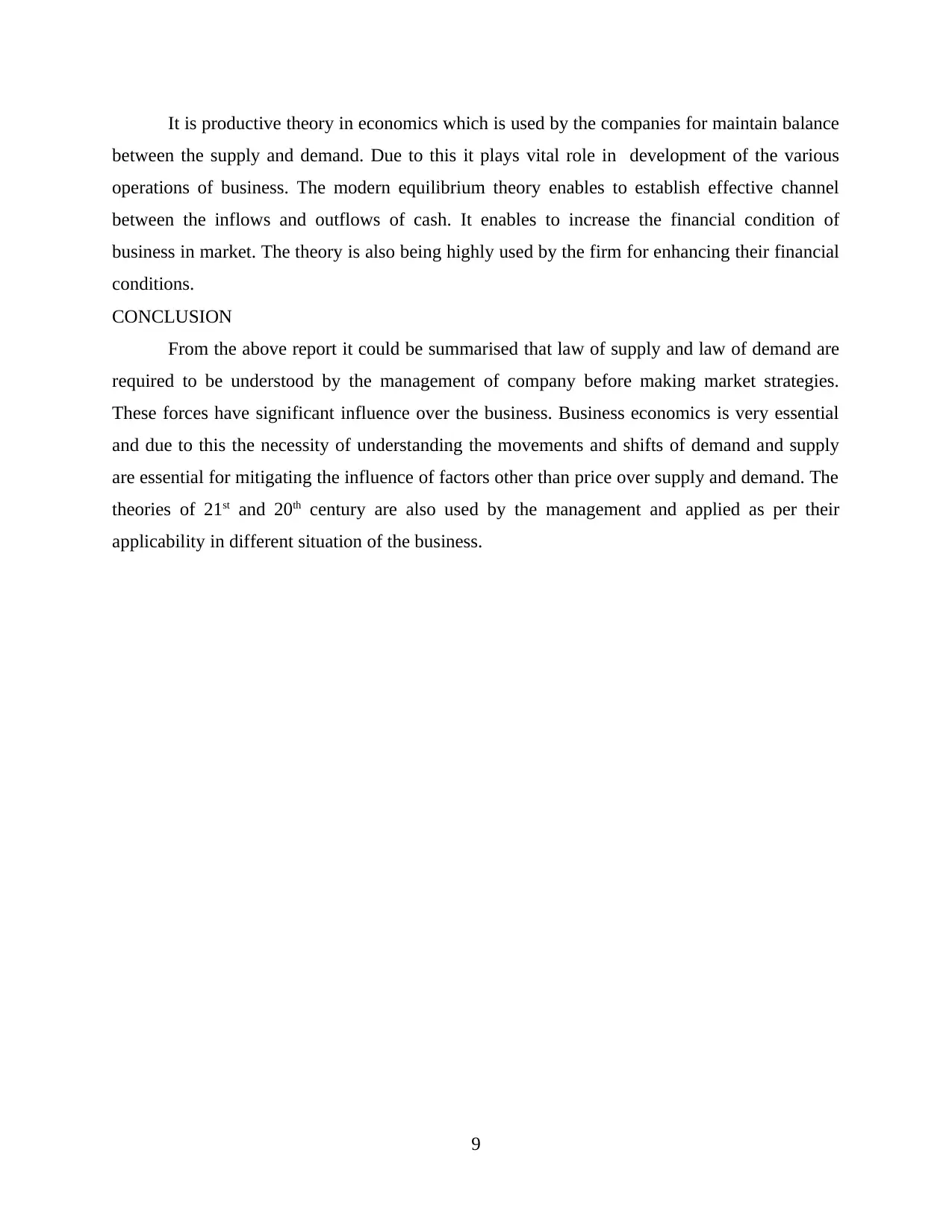
It is productive theory in economics which is used by the companies for maintain balance
between the supply and demand. Due to this it plays vital role in development of the various
operations of business. The modern equilibrium theory enables to establish effective channel
between the inflows and outflows of cash. It enables to increase the financial condition of
business in market. The theory is also being highly used by the firm for enhancing their financial
conditions.
CONCLUSION
From the above report it could be summarised that law of supply and law of demand are
required to be understood by the management of company before making market strategies.
These forces have significant influence over the business. Business economics is very essential
and due to this the necessity of understanding the movements and shifts of demand and supply
are essential for mitigating the influence of factors other than price over supply and demand. The
theories of 21st and 20th century are also used by the management and applied as per their
applicability in different situation of the business.
9
between the supply and demand. Due to this it plays vital role in development of the various
operations of business. The modern equilibrium theory enables to establish effective channel
between the inflows and outflows of cash. It enables to increase the financial condition of
business in market. The theory is also being highly used by the firm for enhancing their financial
conditions.
CONCLUSION
From the above report it could be summarised that law of supply and law of demand are
required to be understood by the management of company before making market strategies.
These forces have significant influence over the business. Business economics is very essential
and due to this the necessity of understanding the movements and shifts of demand and supply
are essential for mitigating the influence of factors other than price over supply and demand. The
theories of 21st and 20th century are also used by the management and applied as per their
applicability in different situation of the business.
9

REFERENCES
Books and Journals
Černe, M., and et.al., 2017. The role of multilevel synergistic interplay among team mastery
climate, knowledge hiding, and job characteristics in stimulating innovative work
behavior. Human Resource Management Journal. 27(2). pp.281-299.
Adamczak, M., and et.al., 2016. The integration between production-logistics system and its task
environment-chosen aspects. IFAC-PapersOnLine. 49(12). pp.656-661.
Juntao, F., and et.al., 2019. Decentralized self-balancing control strategy for the optimal
operation of energy storage systems in network.
Ho, C.C., Pan, C.C. and Chang, L.C., 2017. Determining an optimal action portfolio for water
resource management by using stochastic programming. Water Resources
Management. 31(9). pp.2675-2687.
Mohsenzadeh, A., Sobhanallahi, M.A. and Khamseh, A.A., 2017. A new stochastic demand
model for dual-sourcing supply chain considering disruption risk. International Journal
of Services and Operations Management. 27(1). pp.70-82.
Conroy, T. and Weiler, S., 2016. Does gender matter for job creation? Business ownership and
employment growth. Small Business Economics. 47(2). pp.397-419.
Newton, C., 2020. Covid-19 Scarcity and Household Utility Stock-outs, Shortages, Substitutions,
Other Goods (II).
Dong, D. and Hu, Y., 2017. Study of System Dynamics for Health Care Housing Development
in Panzhihua. In ICCREM 2017 (pp. 175-186).
Hau, H. and Lai, S., 2017. The role of equity funds in the financial crisis propagation. Review of
Finance. 21(1). pp.77-108.
Münster, M., and et.al., 2020. Sector Coupling: Concepts, State-of-the-art and Perspectives.
Online
Demand Curve. 2019. [ONLINE] Available through:
<https://www.britannica.com/topic/demand-curve>
Supply Curve. 2019. [ONLINE] Available through :<https://www.britannica.com/topic/supply-
curve>
10
Books and Journals
Černe, M., and et.al., 2017. The role of multilevel synergistic interplay among team mastery
climate, knowledge hiding, and job characteristics in stimulating innovative work
behavior. Human Resource Management Journal. 27(2). pp.281-299.
Adamczak, M., and et.al., 2016. The integration between production-logistics system and its task
environment-chosen aspects. IFAC-PapersOnLine. 49(12). pp.656-661.
Juntao, F., and et.al., 2019. Decentralized self-balancing control strategy for the optimal
operation of energy storage systems in network.
Ho, C.C., Pan, C.C. and Chang, L.C., 2017. Determining an optimal action portfolio for water
resource management by using stochastic programming. Water Resources
Management. 31(9). pp.2675-2687.
Mohsenzadeh, A., Sobhanallahi, M.A. and Khamseh, A.A., 2017. A new stochastic demand
model for dual-sourcing supply chain considering disruption risk. International Journal
of Services and Operations Management. 27(1). pp.70-82.
Conroy, T. and Weiler, S., 2016. Does gender matter for job creation? Business ownership and
employment growth. Small Business Economics. 47(2). pp.397-419.
Newton, C., 2020. Covid-19 Scarcity and Household Utility Stock-outs, Shortages, Substitutions,
Other Goods (II).
Dong, D. and Hu, Y., 2017. Study of System Dynamics for Health Care Housing Development
in Panzhihua. In ICCREM 2017 (pp. 175-186).
Hau, H. and Lai, S., 2017. The role of equity funds in the financial crisis propagation. Review of
Finance. 21(1). pp.77-108.
Münster, M., and et.al., 2020. Sector Coupling: Concepts, State-of-the-art and Perspectives.
Online
Demand Curve. 2019. [ONLINE] Available through:
<https://www.britannica.com/topic/demand-curve>
Supply Curve. 2019. [ONLINE] Available through :<https://www.britannica.com/topic/supply-
curve>
10
1 out of 12
Related Documents
Your All-in-One AI-Powered Toolkit for Academic Success.
+13062052269
info@desklib.com
Available 24*7 on WhatsApp / Email
![[object Object]](/_next/static/media/star-bottom.7253800d.svg)
Unlock your academic potential
© 2024 | Zucol Services PVT LTD | All rights reserved.



